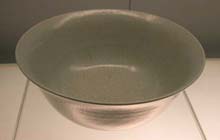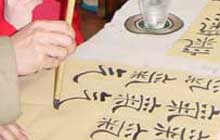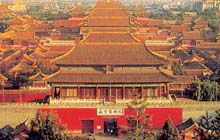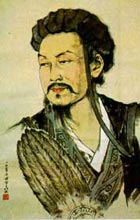The history of Chinese ceramics began some eight thousand years ago with the crafting of hand-molded earthenware vessels. Soon after, in the late neolithic period, the potter's wheel was invented facilitating the production of more uniform vessels. The sophistication of these early Chinese potters is best exemplified by the legion of terracotta warriors found in the tomb of Emperor Qin (r. 221-206 BC).
Over the following centuries innumerable new ceramic technologies and styles were developed. » Read more »
» Read more »According to ancient lore, when a Chinese man named Cangjie learned the divine secret of writing, the spirits were so angry that millet rained from heaven.
Perhaps this was because one of the first applications of the Chinese pictograph system was in the practice of divination. This long-standing association between pictographs and the occultforces of nature helps explain the historic and continuing importance the Chinese people attach to writing and to the art of calligraphy. » Read more »
» Read more »Home of the Emperor, the Forbidden Palace was constructed in accordance with the laws of geomancy or fengshui. Every element was considered according to its prescriptions, the most fundamental being the positioning of the palace along a north-south axis.
The occult art of numerology similarly played a significant part within the palace's architecture. Since odd numbers are thought to be masculine and even ones feminine, the number nine, the "ultimate masculine" number, » Read more »
» Read more »Before the introduction of the engine, trackers were an indispensable feature of transport along the Yangzi. These river people battled daily with the river, providing the muscle to drag 40-100 ton vessels 1500 miles from Shanghai to Chongqing up a series of treacherous gorges and against a current of 6-12 knots. Mostly men, they worked like cattle for 12 hours a day, nine days at a time, to earn enough money to feed themselves poorly and every so often escape to an opium-fueled Elysium. » Read more »
» Read more »"The empire, long divided, must unite; long united, must divide." So begins the historical fiction "The Three Kingdoms" with a line as recited by the Chinese Diaspora as "To be or not to be" in the West.
These days many Western business schools introduce Eastern strategic thinking through Sun Tzu's treatise, "The Art of War". One imagines that there is no better primer for mediaeval battle. However, for an introduction to the Chinese conception of diplomacy, » Read more »
» Read more »


